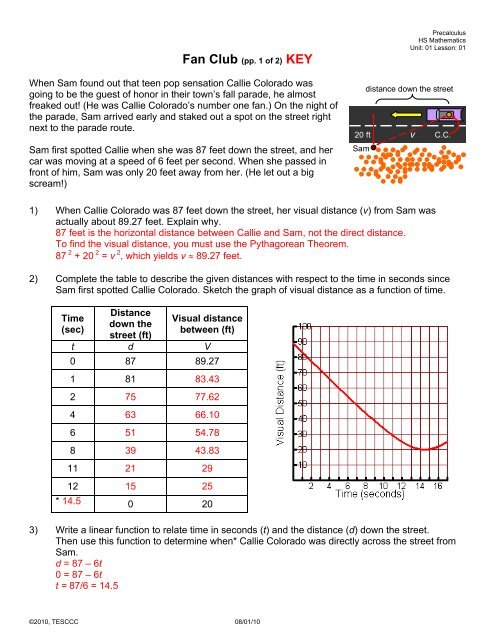When Sam found out that teen pop sensation ... - Bob Hope School
When Sam found out that teen pop sensation ... - Bob Hope School
When Sam found out that teen pop sensation ... - Bob Hope School
Create successful ePaper yourself
Turn your PDF publications into a flip-book with our unique Google optimized e-Paper software.
Fan Club (pp. 1 of 2) KEY<br />
<strong>When</strong> <strong>Sam</strong> <strong>found</strong> <strong>out</strong> <strong>that</strong> <strong>teen</strong> <strong>pop</strong> <strong>sensation</strong> Callie Colorado was<br />
going to be the guest of honor in their town’s fall parade, he almost<br />
freaked <strong>out</strong>! (He was Callie Colorado’s number one fan.) On the night of<br />
the parade, <strong>Sam</strong> arrived early and staked <strong>out</strong> a spot on the street right<br />
next to the parade r<strong>out</strong>e.<br />
<strong>Sam</strong> first spotted Callie when she was 87 feet down the street, and her<br />
car was moving at a speed of 6 feet per second. <strong>When</strong> she passed in<br />
front of him, <strong>Sam</strong> was only 20 feet away from her. (He let <strong>out</strong> a big<br />
scream!)<br />
©2010, TESCCC 08/01/10<br />
20 ft v<br />
<strong>Sam</strong><br />
Precalculus<br />
HS Mathematics<br />
Unit: 01 Lesson: 01<br />
distance down the street<br />
1) <strong>When</strong> Callie Colorado was 87 feet down the street, her visual distance (v) from <strong>Sam</strong> was<br />
actually ab<strong>out</strong> 89.27 feet. Explain why.<br />
87 feet is the horizontal distance between Callie and <strong>Sam</strong>, not the direct distance.<br />
To find the visual distance, you must use the Pythagorean Theorem.<br />
87 2 + 20 2 = v 2 , which yields v � 89.27 feet.<br />
2) Complete the table to describe the given distances with respect to the time in seconds since<br />
<strong>Sam</strong> first spotted Callie Colorado. Sketch the graph of visual distance as a function of time.<br />
Time<br />
(sec)<br />
Distance<br />
down the<br />
street (ft)<br />
Visual distance<br />
between (ft)<br />
t d V<br />
0 87 89.27<br />
1 81 83.43<br />
2 75 77.62<br />
4 63 66.10<br />
6 51 54.78<br />
8 39 43.83<br />
11 21 29<br />
12 15 25<br />
* 14.5 0 20<br />
3) Write a linear function to relate time in seconds (t) and the distance (d) down the street.<br />
Then use this function to determine when* Callie Colorado was directly across the street from<br />
<strong>Sam</strong>.<br />
d = 87 – 6t<br />
0 = 87 – 6t<br />
t = 87/6 = 14.5<br />
C.C.
Fan Club (pp. 2 of 2) KEY<br />
©2010, TESCCC 08/01/10<br />
Precalculus<br />
HS Mathematics<br />
Unit: 01 Lesson: 01<br />
4) What function rule can be used to find the visual distance (v) between <strong>Sam</strong> and Callie in terms<br />
of t (time in seconds)?<br />
v(t) =<br />
2 2<br />
(87 - 6x) + 20<br />
5) Use this function rule to complete the following table for selected values of t.<br />
Time<br />
(sec)<br />
Distance<br />
down the<br />
street (ft)<br />
Visual distance<br />
between (ft)<br />
t d v<br />
A -5 117 118.70<br />
B 13 9 21.93<br />
C 16 -9 21.93<br />
D 34 -117 118.70<br />
6) Do your answers for point A (above) make sense in the context of the problem situation?<br />
What could these numbers represent?<br />
Yes. This could mean <strong>that</strong> 5 seconds before <strong>Sam</strong> spotted Callie, her car was 117 feet down the<br />
street, at a visual distance of 118.7 feet.<br />
7) Do your answers for point D (above) make sense in the context of the problem situation?<br />
What could these numbers represent?<br />
Yes. This could mean <strong>that</strong> 34 seconds after <strong>Sam</strong> spotted Callie, her car was 117 feet down the<br />
street in the other direction (to the left), at a visual distance of 118.7 feet.<br />
8) What restrictions, if any, must be placed on the domain of this function?<br />
None. The domain of the function includes all real numbers (or, (-�, �)).<br />
9) Are there any restrictions on the domain and range of the problem situation?<br />
Since the closest <strong>Sam</strong> gets to Callie is 20 ft, the range would only include values greater than<br />
or equal to 20 (or, [20, �)). The domain, however, is only limited by the amount of time <strong>Sam</strong><br />
may have stood on the street before or after he spotted Callie in the parade (or, by the length of<br />
time the parade lasted, or by the length of the street, etc.).




